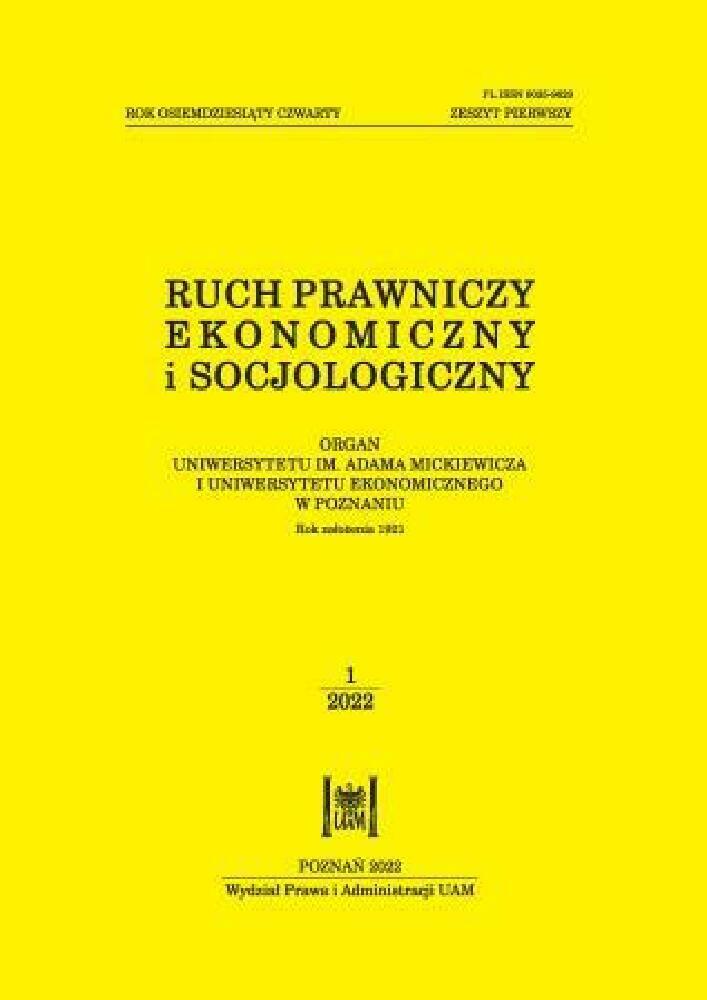Abstrakt
Procedura przymusowej restrukturyzacji została wprowadzona do polskiego porządku prawnego przez ustawę z 10 czerwca 2016 r. o Bankowym Funduszu Gwarancyjnym, systemie gwarantowania depozytów oraz przymusowej restrukturyzacji. Niemniej, dopiero trzy i pół roku po wejściu w życie tej ustawy doszło do pierwszego przypadku wszczęcia wyżej wskazanego postępowania wobec Podkarpackiego Banku Spółdzielczego w Sanoku. Trzy miesiące później postępowanie to zostało uruchomiono po raz drugi – wobec Banku Spółdzielczego w Przemkowie. Te pierwsze dwa przypadki zastosowania przymusowej restrukturyzacji przez Bankowy Fundusz Gwarancyjny pozwalają na dokonanie wstępnej analizy dopiero rozwijającej się praktyki decyzyjnej organu w tej materii. Spod analizy wyłączona zostanie decyzja BFG ws. przymusowej restrukturyzacji Idea Bank S.A., która ze względu na znacznie większe znaczenie tego banku dla polskiego systemu finansowego zasługuje na oddzielne omówienie. Artykuł skupia się w szczególności na zbadaniu podejścia BFG do przesłanki interesu publicznego, której spełnienie zgodnie z art. 101 ust. 7 pkt 3) uBFG jest warunkiem uruchomienia przymusowej restrukturyzacji. Przesłanka ta ma kluczowe znaczenie dla ochrony praw posiadaczy praw właścicielskich i wierzycieli podmiotu w restrukturyzacji, które ulegają poważnemu ograniczeniu w trakcie przymusowej restrukturyzacji mogącej prowadzić nawet do umorzenia instrumentów właścicielskich i części zobowiązań. Zapewnienie, że organ nie interpretuje tej przesłanki zbyt szeroko jest z perspektywy praw jednostki bardzo ważne. W artykule po krótce omówiona została procedura przymusowej restrukturyzacji. Następnie w sposób bardziej szczegółowy opisano przesłankę interesu publicznego. W części trzeciej przeanalizowane zostało podejście BFG do interesu publicznego w ww. dwóch postępowaniach ws. przymusowej restrukturyzacji.
Bibliografia
Binder, J.-H. (2019). Bank bail-in and disputed claims: can it cope? The case for and against a vis attractive resolutionis. EBI Working Paper Series 32.
Binder, J.-H. (2020). Proportionality at the Resolution Stage: Calibration of Resolution Measures and the Public Interest Test. European Business Organization Law Review 2(21): 453–474.
Deslandes, J., Dias, C., Magnus, M. (2019). Liquidation of Banks: towards an ‘FDIC’ for the Banking Union. Brussels: European Parliament In-depth analysis.
Dorociak, M. (2020). Restrukturyzacja i uporządkowana likwidacja z perspektywy zasady wolności gospodarczej, [w:] R. Grzeszczak (red.), Wolność gospodarcza a regulacja rynków na przy-kładzie wpływu unijnych i krajowych regulatorów rynków na działalność przedsiębiorców. Warszawa: C.H. Beck: 287–302.
Fucile, P. (2019). Resolution framework and the protection of fundamental rights, [w:] G. Lo Schiavo (red.), The European Banking Union and the Role of Law. Cheltenham: Edward Elga Publishing: 259–272.
Gelpern, A., Veron, N. (2019). An Effective Regime for Non-viable Banks: US Experience and Considerations for EU Reform. Brussels: European Parliament Study.
Grzeszczak, R., Szmigielski, A. (2015). Sądowe stosowanie Karty Praw Podstawowych UE w odniesieniu do państw członkowskich – refleksje na podstawie orzecznictwa Trybunału Sprawiedliwości i praktyki sądów krajowych. Europejski Przegląd Sądowy 10: 11–18.
Lastra, R.M., Olivares-Caminal, R., Russo, C.A. (2017). The Provision of Critical Functions at Global, National and Regional Level – Is there a need for further legal/regulatory clarification if liquidation is the default option for failing banks? Brussels: In-depth analysis requested by the ECON committee.
Lastra, R.M., Russso, C.A., Bodellini, M. (2019). Stock take of the SRB’s activities over the past years: what to improve and focus on? Brussels: European Parliament Study.
Lienemeyer, M., Kerle, C., Malikova, H. (2014). The new state aid banking communication: the beginning of the bail-in era will ensure a level playing field of enhanced burden sharing. European State Aid Law Quarterly 2(13): 277–288.
Merler, S. (2017). Critical functions and public interest in banking services: need for clarification? Brussels: In-depth analysis requested by the ECON committee.
Półtorak, N. (2014). Zakres związania państw członkowskich Kartą Praw Podstawowych Unii Europejskiej. Europejski Przegląd Sądowy 9: 17–28.
Sibert, A. (2012). Bank Resolution Regimes. Brussels: European Parliament Study. Skrenty, Ż. (2013). Zaufanie obywateli do organów władzy publicznej w świetle orzecznictwa sądowego i poglądów doktryny. Studia Lubuskie 9: 97–112.
Wojcik, K.P. (2016). Bail-in in the banking union. Common Market Law Review 53: 91–138.
Licencja
Prawa autorskie (c) 2022 WPiA UAM

Utwór dostępny jest na licencji Creative Commons Uznanie autorstwa – Użycie niekomercyjne – Bez utworów zależnych 4.0 Międzynarodowe.





